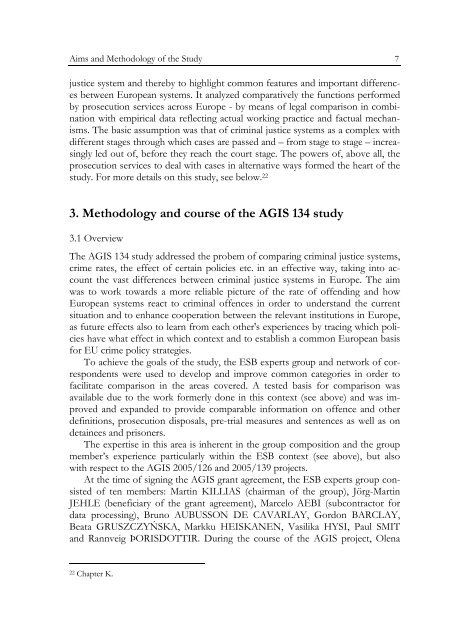Defining and Registering Criminal Offences and Measures - Oapen
Defining and Registering Criminal Offences and Measures - Oapen
Defining and Registering Criminal Offences and Measures - Oapen
You also want an ePaper? Increase the reach of your titles
YUMPU automatically turns print PDFs into web optimized ePapers that Google loves.
Aims <strong>and</strong> Methodology of the Study 7<br />
justice system <strong>and</strong> thereby to highlight common features <strong>and</strong> important differences<br />
between European systems. It analyzed comparatively the functions performed<br />
by prosecution services across Europe - by means of legal comparison in combination<br />
with empirical data reflecting actual working practice <strong>and</strong> factual mechanisms.<br />
The basic assumption was that of criminal justice systems as a complex with<br />
different stages through which cases are passed <strong>and</strong> – from stage to stage – increasingly<br />
led out of, before they reach the court stage. The powers of, above all, the<br />
prosecution services to deal with cases in alternative ways formed the heart of the<br />
study. For more details on this study, see below. 22<br />
3. Methodology <strong>and</strong> course of the AGIS 134 study<br />
3.1 Overview<br />
The AGIS 134 study addressed the probem of comparing criminal justice systems,<br />
crime rates, the effect of certain policies etc. in an effective way, taking into account<br />
the vast differences between criminal justice systems in Europe. The aim<br />
was to work towards a more reliable picture of the rate of offending <strong>and</strong> how<br />
European systems react to criminal offences in order to underst<strong>and</strong> the current<br />
situation <strong>and</strong> to enhance cooperation between the relevant institutions in Europe,<br />
as future effects also to learn from each other's experiences by tracing which policies<br />
have what effect in which context <strong>and</strong> to establish a common European basis<br />
for EU crime policy strategies.<br />
To achieve the goals of the study, the ESB experts group <strong>and</strong> network of correspondents<br />
were used to develop <strong>and</strong> improve common categories in order to<br />
facilitate comparison in the areas covered. A tested basis for comparison was<br />
available due to the work formerly done in this context (see above) <strong>and</strong> was improved<br />
<strong>and</strong> exp<strong>and</strong>ed to provide comparable information on offence <strong>and</strong> other<br />
definitions, prosecution disposals, pre-trial measures <strong>and</strong> sentences as well as on<br />
detainees <strong>and</strong> prisoners.<br />
The expertise in this area is inherent in the group composition <strong>and</strong> the group<br />
member’s experience particularly within the ESB context (see above), but also<br />
with respect to the AGIS 2005/126 <strong>and</strong> 2005/139 projects.<br />
At the time of signing the AGIS grant agreement, the ESB experts group consisted<br />
of ten members: Martin KILLIAS (chairman of the group), Jörg-Martin<br />
JEHLE (beneficiary of the grant agreement), Marcelo AEBI (subcontractor for<br />
data processing), Bruno AUBUSSON DE CAVARLAY, Gordon BARCLAY,<br />
Beata GRUSZCZYŃSKA, Markku HEISKANEN, Vasilika HYSI, Paul SMIT<br />
<strong>and</strong> Rannveig ÞORISDOTTIR. During the course of the AGIS project, Olena<br />
22 Chapter K.

















